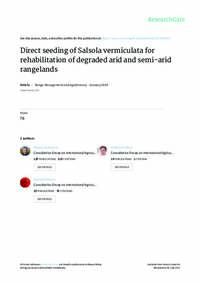Direct seeding of Salsola vermiculata for rehabilitation of degraded arid and semi-arid rangelands

Authors:
Proper soil preparation provides the basis for good seed
germination and establishment of steppe vegetation in
the arid and semi-arid areas of West Asia and North
Africa. Salsola vermiculata is a key shrub species of the
region and contributes to rangeland and livestock
productivity. The aim of this study was to evaluate the
establishment of S. vermiculata using three different soil
preparation techniques since transplanting is often cost
prohibitive. This study also aims to assess the
establishment in different gradients of gentle landscape
depressions for scarification and furrowing; at the top,
on slope and at the core. The experiment was conducted
in the semi-arid steppe of the Hama District in Syria with
three establishment treatments viz., scarification (SC),
pitting machine (PM) and furrowing (FR). Our results
indicated that the density of S. vermiculata under
scarification treatment is 10 folds higher (P < 0.05) than
the other two techniques. The results suggest that direct
seeding with superficial soil surface scarification may
provide a significant remedy for the rehabilitation of
degraded arid rangelands. Seeding densities tested on
different gradients of landscape depressions were
highest on the top, followed by on slope for both furrowing
and scarification.
